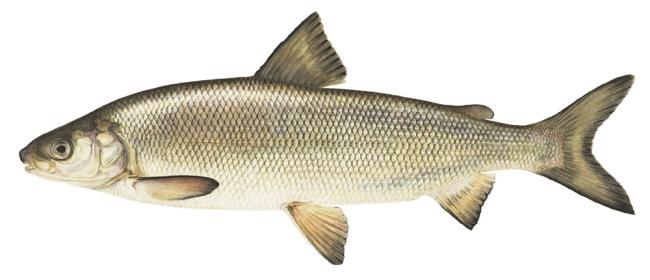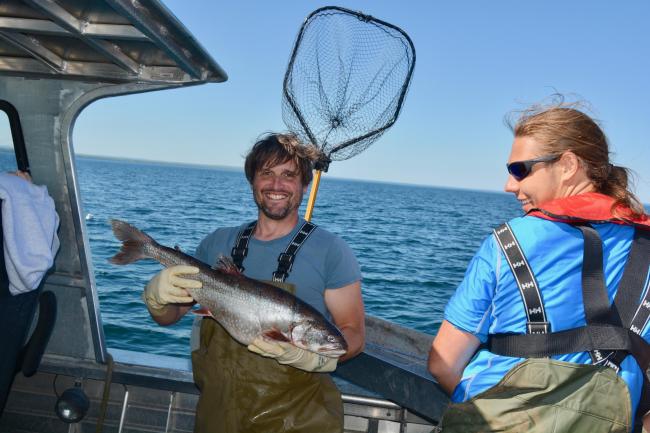The Great Lakes Section focuses much of its time on namegos (lake trout), adikameg (whitefish), and odoonibiins (cisco, a.k.a. lake herring), which are a culturally and nutritionally important source of low fat, high protein food which is readily found in local markets.
The Great Lakes Section works to ensure treaty reserved fishing rights are preserved by assisting its member Tribes in fishery assessments and regulation of Gichigami (Lake Superior) treaty commercial fisheries. GLIFWC member bands who fish commercially in Lake Superior include the Red Cliff and Bad River Bands of Lake Superior Chippewa Indians in Wisconsin and the Keweenaw Bay and Bay Mills Indian Communities in Michigan and the Fond du Lac Band of Lake Superior Ojibwe in Minnesota.
For more information on the Bay Mills Indian Community's harvest practices, please visit Chippewa Ottawa Resource Authority (CORA), the Intertribal Management for the 1836 Treaty Fishery.
Large and small boat fishers are licensed through their respective tribes and must adhere to tribally adopted codes regulating the fishery.
Fish harvest monitoring occurs year-round in off-reservation fishing grounds of the 1842 Treaty Ceded territory within Michigan waters of Lake Superior where measuring length, weight and removing the otolith (ear bone) to estimate age from commercially harvested giigoonh (fish) is a priority of the Great Lakes Fisheries Section.
A guide to avoiding trap nets and gill nets in the Great Lakes.
An in-depth read on Great Lakes Fisheries

Whitefish are very important to the tribal commercial fishery which supports many jobs and provides food to the local area. The Great Lakes Section conducts assessments to identify discrete stocks, determine the distribution, track the relative abundance, and collect biological characteristics (length, weight, age) of adikameg.
Spawning concentrations of adikameg are sampled by setting gill nets at predetermined spawning locations in management units of the 1842 Treaty ceded area within Michigan waters of Gichigami. Relative abundance is tracked by calculating the number of adikameg captured per net. Stock health is tracked by measuring the length and weight and determining the age of the fish from otoliths (ear bones).

Lake Sturgeon are identified as a culturally sensitive species under the American Indian Natural Heritage Restoration Program by the Fond du Lac, Red Cliff, and Bad River Bands of Lake Superior Chippewa, and the Keweenaw Bay and Bay Mills Indian Communities. The harvest and sharing of sturgeon is important to the culture of the Anishinaabe people.
Sturgeon continue to be harvested for ceremonial and subsistence purposes by tribal members, and are assessed by the Great Lakes Section annually in Gichigami. Relative abundance, length, weight, and girth are collected to track the health of the fish population. Sturgeon are tagged with individually numbered tags and recaptured fish provide information on movement and growth.
Lake trout are the keystone predator of Gichigami. A voracious predator and good to eat, namegos are sought after by the tribal commercial fishery and sport fishers alike.
Due to the vulnerability of namegos to bimiizii and fishing gear, biologists track the fish's abundance through sophisticated stock assessment models which explain past and predict future numbers of namegos in Gichigami.
The Great Lakes Section conducts fish assessments and seeks funding to carry out special projects which provide information used in the models. Spawning concentrations of namegos are sampled by setting gill nets at predetermined spawning locations in management units of the 1842 Treaty ceded area within Michigan waters of Gichigami.
Fish captured in good physical condition are tagged with consecutively numbered orange tags and released.
The deep water form of namegos, siscowet lake trout, is sampled annually in waters up to 950 feet (290 meters) deep. Trend and diet information are collected by setting bottom set gill nets over different depth strata. Biological characteristics of captured fish are measured (length, weight), otoliths (fish ear bones) are collected to determine the age of fish, and stomachs are removed to determine the diet of fish back at the lab. This deep water form is less desirable for eating but is found throughout 70% of Gichigami.
“We’ve been working on restoring lake trout in Lake Superior for over 60 years plus, basically since sea lamprey invaded and helped to crash the population,” Bill Mattes, chair of the commission’s Lake Superior Committee, said. “The restoration is now lakewide.

Controlling the invasive bimiizii (sea lamprey) is important to protecting the fishes of Gichigami. For this reason, every spring the Great Lakes Section sets traps in tributaries of Gichigami to capture bimiizii. By trapping bimiizii an estimated number spawning in each tributary is obtained. Also, their spawning potential is reduced by removing a portion of the run. Data is collected on their biological characteristics (length, weight, sex).
This work is done in cooperation with our member tribes, the Great Lakes Fishery Commission, and the U.S. Fish & Wildlife Service–Sea Lamprey Control program (USFWS). Other invasive species such as the bakaan namebin (Asian carp) are also of concern to the tribes. GLIFWC monitors the developments of policy and management with regard to these and other invasive species.

The Great Lakes Section focuses much of its time on namegos (lake trout), adikameg (whitefish), and odoonibiins (cisco, a.k.a. lake herring), which are a culturally and nutritionally important sources of low fat, high protein food which are readily found in local markets.
Fish harvest monitoring occurs year-round in off-reservation fishing grounds of the 1842 Treaty ceded area within Michigan waters of Lake Superior where measuring length and weight and removing age structures from commercially harvested gigoonh (fish) is a priority of the Great Lakes Section.

Boards and Partnerships
Great Lakes Fishery Commission, Lake Superior Committee
GLIFWC's Great Lakes Fisheries Committee
For more information please contact the Great Lakes Section Leader, Biological Services Division.


